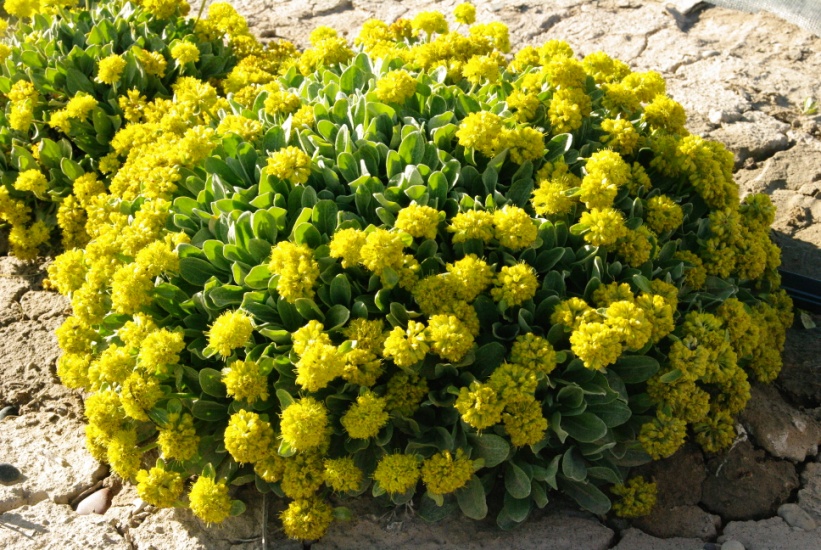Ivy League Buckwheat in the Landscape

Stephen Love, University of Idaho
Scientfic Name: Eriogonum arcuatumCommon Name: Syn. Eriogonum jamesii var. xanthum
Ivy League buckwheat, Baker’s wild buckwheat
Description: Ivy League buckwheat is a long-lived perennial or sub-shrub with a woody crown and evergreen leaves. The foliage forms a very dense mound. The leaves are covered with fuzzy hairs on both surfaces and are silver-green in color. Flower color is bright yellow. The flowers are arranged in sparse umbels on short stems, giving the appearance of individual flower clusters floating at the top of the foliage. Flowers entirely cover the plant for about 6 weeks from May into July. Once bloom is finished, removal of the spent flowers leaves a very attractive silver-green mound. Leaves suffer minimal winter damage and plants appear very attractive in early spring.
Native Habitat: Eriogonum jamesii, the species within which Ivy League buckwheat is currently categorized, is a common plant of the Four Corners region eastward into the southern Great Plains. The less common, yellow-flowering forms of the species are restricted to southern Utah, northern Arizona, and scattered locations in Colorado and New Mexico. The dense, compact form designated as Eriogonum arcuatum by some botanists is limited to the crest of the Rocky Mountains in Colorado and northern New Mexico. Typically grows near or above treeline on rocky slopes and ledges at elevations of 9,000 to 13,000 feet.
Cultural Requirement
Soil: Requires a well-drained soil to ensure long-term survival. Tolerates clay soils if grown in a dry climate or not over-watered. Maintains its best form in nutrient-poor soils. Adapted to alkaline soils.
Moisture Tolerance: Withstands near-xeric conditions but may benefit from limited supplemental water under extended periods of dry weather.
Sun/Shade/Preference: Full sun.
Transplanting: Easily transplanted as seedlings from flats into pots and from pots into the garden. Producing plants of marketable size may require several months. Plants are easily managed in small pots for a short period of time but require a well–drained medium and careful watering to remain healthy for an extended period.
Propagation: Best propagated from seed. Germinates fairly well without seed pretreatments, but germination is often enhanced with a short (2-3 weeks) period of cold stratification. Seedlings can be susceptible to damping-off, a problem usually manageable with proper watering. Difficult to propagate from cuttings.
Maintenance (pruning, fertilization, deadheading, division, irrigation, etc): Plants should be dead-headed after bloom to improve appearance. This is easily accomplished by hand-rubbing the top of the foliage. The plants are otherwise very easy to care for, requiring limited irrigation (one to four times during dry years) and little or no fertilization.
Insect, disease, or other problems: Ivy League buckwheat has no pests of consequence.
Landscape Value
Use in the Landscape: The combination of drought tolerance and mound form makes this a very attractive species in xeric beds and borders when mixed with other low-statured plants, or when placed in front of shrubs or taller plants. Can be used as a repetitive element in either naturalized or formal designs. Makes an excellent rock garden species. Has the season-long attractiveness to serve as a specimen plant in a garden small enough to show off its form.
Foliage: Long, spoon-shaped leaves are fuzzy on both surfaces. The pubescence contributes a silver hue to the foliage. The leaves are arranged radially from the center of the plant, creating a very dense mound. The leaves are evergreen and remain attractive throughout the year.
Flower: Tiny, bright yellow flowers are borne in small, capitate heads which are secondarily arranged in sparse umbels. Combined with very short flower stalks, the resulting effect is of small, distinct flower clusters floating at the top of the foliage.
Timing: May-July.
Fruit: Inconspicuous achene enclosed in a dried perianth. Each flower produces a maximum of one seed.
Form: Mounded form both in and out of bloom.
Texture: Moderately fine.
Ultimate Size: Height: 5 to 8 inches whether in or out of bloom. Width: eventually 2 or more feet wide.
Rate of Growth: Moderately slow. The plant occasionally blooms sparsely the first year and progressively gets larger with more bloom in subsequent years.
Suggested Plant Partners: Ivy League buckwheat is a good companion for many low-growing, xeric grasses and perennials, including: Schizachyrium scoparium, Bouteloua gracilis, Poa secunda, Antennaria rosea, Yucca nana, Artemisia frigid, Calylophus serrulatus, Penstemon ambiguus, and Penstemon pachyphyllus.
Availability: Seed can often be purchased from the Eriogonum Society or from native plant seed suppliers. Potted plants rarely available.
Cultivars: None.
References:

